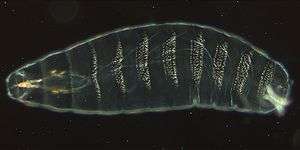Faint little ball
Faint little ball (flb) is a Drosophila gene that encodes the Drosophila epidermal growth factor receptor (DER) homolog.[1] The gene is also called torpedo and Ellipse.[2] The gene is located at 3-26 of the Drosophila melanogaster genome. It is named faint little ball because when the gene is mutated the embryo forms a ball of dorsal hypoderm.[3] flb is necessary for several processes to occur during embryonic development, specifically in central nervous system development. It is expressed as quickly as 4 hours after fertilization of the egg. The peak of expression of the flb gene is between 4–8 hours into development. In all processes that are facilitated by flb the same signal transduction pathway is used.[4] Drosophila EGF receptor is involved in the development of embryos as well as larvae/pupae's wings, eyes, legs and ovaries.[1]
| Epidermal growth factor receptor | |||||||
|---|---|---|---|---|---|---|---|
| Identifiers | |||||||
| Organism | |||||||
| Symbol | Egfr | ||||||
| Alt. symbols | flb | ||||||
| UniProt | P04412 | ||||||
| |||||||
Interactions
Whether looking at development in embryos or larvae/pupae, DER relies on several ligands to carry out its function. These are called SPITZ, ARGOS and Gurken. The efficiency of DER corresponds with the sum of these three ligands. As of yet the exact purpose of these ligands in the pathway of DER is unknown, but when expression of these ligands is altered from normal, aberrant phenotypes of the embryos can be observed.[1] When DER is over utilized in the cell because of increases in ligand, phenotypic abnormalities can be visualized such as hyperplasia of the head midline structures.[5] The flb gene also has interactions with the proteins Rhomboid and Star. Rhomboid is a protease that cleaves ligands such as Spitz so that they can come into contact with receptors such as DER and begin activate a signal trasduction pathway.

Function
Expression of the flb gene can be seen as early as four hours into the development of Drosophila melanogaster. At four hours the gene is facilitating the retraction of the germ band as well as structuring the beginnings of the CNS. At six hours the gene is used to differentiate epidermal cells to secrete denticle belts which begin segmentation of the larva. At nine hours the gene is used for the differentiation of midline glial cells.[4] When this gene is mutated or any of its interactions are altered phenotypes such as fused commissures can be seen as a result of improper segregation.
Mutation
When the flb gene is mutated, several phenotypic abnormalities during development can be viewed. The first is that the embryo will form a ball of dorsal hypoderm.[3] This is because flb is responsible for the formation of the ventral cuticle.[1] Without the complete formation of the ventral cuticle only dorsal structures will be present. Since flb plays a role in the formation of the CNS and the eye, head structures will be underdeveloped or not present at all.[3][4] Another function of the gene is to retract the germ band.[1] This will not occur if the flb is mutated.[3] There are other hypomorphic alleles that also contribute to the retraction of the germ-band, which allow for a spectrum of severity in the phenotype of embryos but they will not recover the Wild Type phenotype completely.[3] This gene is necessary for the development of embryos and if it is not expressed in the appropriate way, it is lethal to the embryo.
References
- Schweitzer R, Shilo BZ (May 1997). "A thousand and one roles for the Drosophila EGF receptor". Trends in Genetics. 13 (5): 191–6. doi:10.1016/S0168-9525(97)01091-3. PMID 9154002.
- Schejter ED, Shilo BZ (March 1989). "The Drosophila EGF receptor homolog (DER) gene is allelic to faint little ball, a locus essential for embryonic development". Cell. 56 (6): 1093–104. doi:10.1016/0092-8674(89)90642-9. PMID 2924351.
- Lindsley DL, Zimm GG (2012-12-02). The Genome of Drosophila melanogaster. Academic Press. ISBN 9780323139847.
- Raz E, Shilo BZ (January 1992). "Dissection of the faint little ball (flb) phenotype: determination of the development of the Drosophila central nervous system by early interactions in the ectoderm". Development. 114 (1): 113–23. PMID 1576953.
- Dumstrei K, Nassif C, Abboud G, Aryai A, Aryai A, Hartenstein V (September 1998). "EGFR signaling is required for the differentiation and maintenance of neural progenitors along the dorsal midline of the Drosophila embryonic head". Development (Cambridge, England). 125 (17): 3417–26. PMID 9693145.